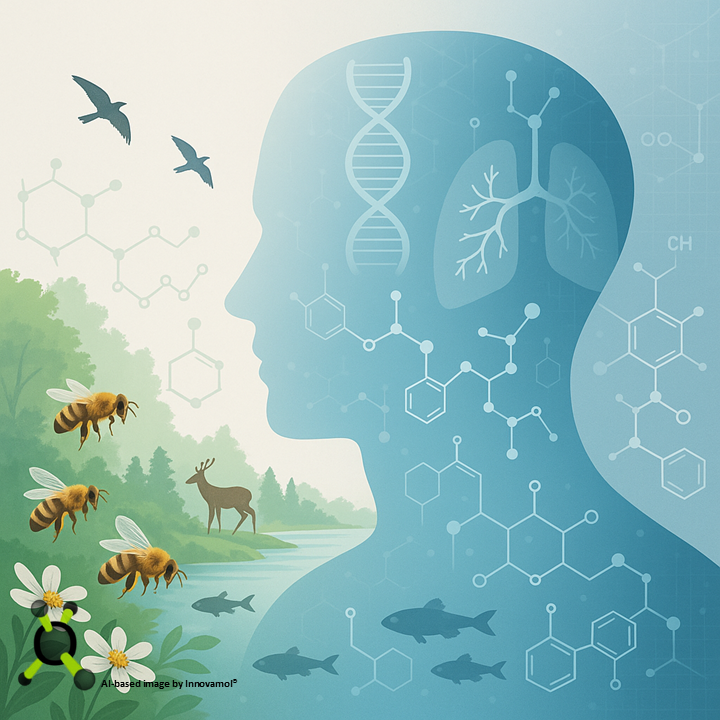Last month, part of our team had the pleasure of attending the JRC Summer School on Non-Animal Approaches in Science, held in Ispra (VA), Italy. The event gathered students and professionals from all over the world to explore New Approach Methodologies (NAMs), which are innovative methods in chemical and pharmaceutical safety assessment that move away from traditional animal testing. Among the most engaging activities of the programme there was a structured debate on whether we should integrate human and environmental data, and translate findings across biological systems.
One of the key ideas discussed was the concept that much of our biology is shared across species. Indeed, evolution has conserved many toxicological mechanisms, such as oxidative stress and receptor-mediated effects, which means that if a given chemical affects one species via a known biological pathway, it may well have similar effects in another. This scientific reasoning supports a more unified approach to evaluating risks, recognising biology not in isolation but as part of a continuous, interconnected system.
Supporting this concept, is the Adverse Outcome Pathway framework (AOPs), which links chemical interactions at the molecular level to broader biological effects, including impacts on entire populations. These pathways are intentionally designed to be cross-species, enabling scientists to extrapolate findings from one organism to another when the underlying biology is sufficiently conserved. In addition, modern science nowadays offers many other robust tools and frameworks to make this integration feasible. For instance, SeqAPASS, allows researchers to compare specific protein targets across hundreds of species to assess whether a chemical interaction observed in one might be relevant in another. Another tool is G2P-SCAN that goes further by evaluating entire biological pathways for their degree of conservation, providing greater confidence in the validity of cross-species predictions. Other frameworks like Physiologically Based PharmacoKinetic (PBPK) models help simulate how a substance is processed in different organisms, offering insights into internal doses and expected biological effects. Another one is the Integrated Chemical Environment (ICE) that brings together curated toxicological data, predictive models, and analysis tools to support decision-making. Meanwhile, traditional Quantitative Structure-Activity Relationship (QSAR) have evolved in recent years and a notable example is the comprehensive framework developed by the OECD (Series of Testing and Assessment No. 386), which provides harmonised principles for the regulatory assessment of both QSAR model and predictions based on multiple outputs.
Efficiency and ethics were also discussed as core benefits of an integrated approach. By reusing data and focusing testing efforts where they are most informative, researchers can reduce both costs and animal use. Computational and in vitro methods help avoid redundant experiments while still supporting high standards of public and environmental protection.
This approach aligns perfectly with the European One Health approach, which recognises the deep interconnection between human, animal, and environmental health. Chemicals do not exist in a vacuum! They circulate through ecosystems, affecting multiple species, including humans. Thus, an integrated method that reflects this complexity is not only more realistic but also more responsible.
Of course, criticisms also emerged during the debate. Some questioned whether species differences in physiology, exposure, and life history are too great to allow meaningful integration. Others raised concerns about the readiness of AOPs and the potential for blurred regulatory priorities. Still, it was countered that species differences are already accounted for in existing toxicology, and that frameworks like AOPs, along with tools such as SeqAPASS and PBPK models, offer a mechanistic basis for cautious, evidence-based extrapolation. Importantly, integration does not mean merging all goals but rather connecting relevant insights to support both human and environmental health with greater precision.
At Innovamol, we believe that integrated chemical safety assessment represents not only a scientific evolution, but a necessary one. In a world where human and ecological systems are deeply interconnected, our regulatory science must reflect that reality. Embracing shared biology, leveraging cutting-edge tools, and advancing ethical practices can lead us toward more accurate, efficient, and humane assessments. Integration is not a compromise, but it’s a commitment to better science for a healthier world.
“The whole of science is nothing more than a refinement of everyday thinking” – Albert Einstein

